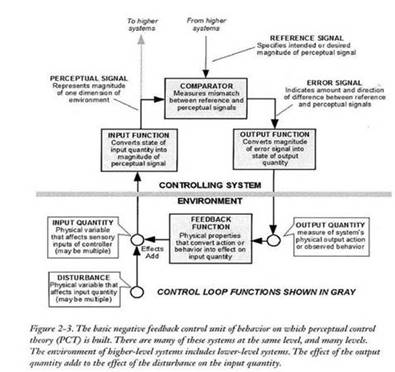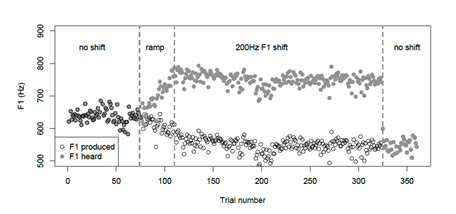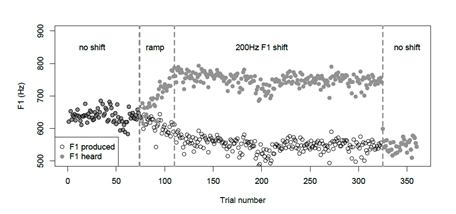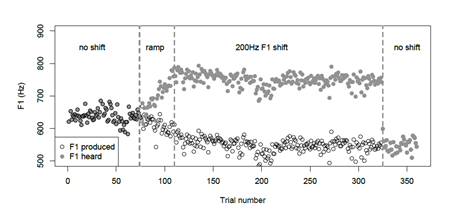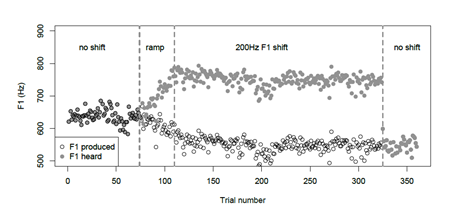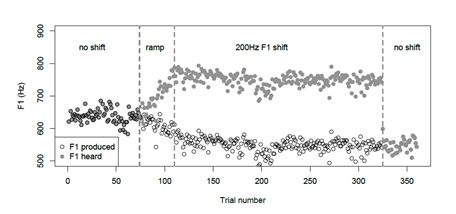···
From: Richard Marken (rsmarken@gmail.com via csgnet Mailing List) csgnet@lists.illinois.edu
Sent: Thursday, June 7, 2018 4:40 AM
To: csgnet@lists.illinois.edu
Cc: Richard Marken rsmarken@gmail.com
Subject: Behavior is control (was Re: The controlled quantity (q.i) is data…)
[Rick Marken 2018-06-06_19:40:05]
[Bruce Nevin 2018-06-05_12:09:33 ET]
BN: For the sake of those who might be interested in the context of that passage, it’s from p. 115 of LCS (the first collection). As Bill says in the quoted passage, “There is no need to think of all controlled quantities as simple physical variables: force, angle, position. Human beings are equipped to perceive not only such elementary variables, but highly complex functions of such variables.” The context of this passage is a general introduction to the notion of a perceptual hierarchy (reference 12 points to Hayek’s 1952 book for corroboration) and the notion of hierarchical control. He’s not talking about quantities measured in an experiment. And except at the very lowest level he’s not talking about immediate input from the environment.
RM: Right. He’s just talking about what controlled quantities are. Controlled quantities (which can also be called controlled variables) are rarely measured in experiments since so few people are doing PCT research.
HB : Well I doubt that “controlled quantites” (eg.controlled variables, e.g. perceptual signals) are rarely measured because few people are doing PCT research. I think it’s more problem in defining what other people control (what reference state for the perception they set). I understood that you thought the same.
RM (2013) : But the intentional behavior that occurs in real life often involves the control of variables that are impossible to represent as simple function of physical variables, e.g., the honesty of a communication or the intimacy of a realtionship. A quantitative approcah to the TCV will not work when trying to study such abstract variables…
HB : I thought it’s clear that there are difficulties when we want to find out what other people control in their real life. Usualy they don’t do TCV but anyway there is some natural “instinct” that tells people what others might be controlling and whether it could affect their control. That’s probably what is important in real life of people. How to control opitmal.
RM : But it’s important to be able to recognize controlled quantities outside the lab (in everyday behavior) because PCT is based on the observation that all purposeful behavior is the behavior of controlled quantities.
HB : What exactly does this mean and where Bill wrote that ??? What a construct : “all purposeful behavior is the behavior of controlled quantities”. Does this mean that behavior is produced by “controlled quantites”.
What exactly did you mean by this ? Does this mean that “perceptual signal” as “controlled quantity” are “controlled variables” that direct behavior or “controlled quantites produce behavior”. This is in accordance to your behavoristic ideas of “stimulus-respons”.
We can maybe conclude that “Perceptual signal” is formed on the basis of stimulus from environment and produce behavior which is “the behavior of controlled quantities”. So it looks like that It’s stimulus that “creates” perceptual signal and perceptual signal or “controlled quantiy” cause behavior. Is this what you meant by your briliant definition.
How this is in accordance to PCT definition of control ?
Bill P (B:CP):
CONTROL : Achievement and maintenance of a preselected state in the controlling system, through actions on the environment that also cancel the effects of disturbances.
HB : I think that the only we find out what “purposeful behavior” is that we must compare what you wrote with what Bill wrote about PCT. If we want to talk about PCT I hope you agree that we must have some references that will tell us whether we are in accordance with PCT or not.
So is your statement “Behavior of controlled quantities” in accordance with definition of control ?
HB : What is your “purposefull behavior of controlled quantity” for in control loop ?
From definition of control I’d say that “actions” or “purposefull behavior” means cancelling the effects of disturbances so that organism achieves and maintains predefined state e.g. “intrinsic variables” in genetically determined reference states. That’s how organisms survive.
Purpsosefull behavior is the result of “errors” in intrinsic variables. As we know from Bills’ definitions “errors” are eliminated with internal and external effectors.
Activity of external effectors are usually called in PCT actions.
So “Purposeful behavior is result” of discrepancy between references and perceptual signals that carry informations about state of “intrinsic variables”. By the way. I hope now you understand why Martin was right.
RM (earlier about Martin) ….perceptual signals that are analogs of a subset of those quantities – presumably the ones that, when controlled, allow us to keep our intrinsic variables under control.
Bill P :
ERROR : The discrepancy between a perceptual signal and a reference signal, which drives a control system’s output function. The discrepancy between a controlled quantity and it’s present reference level, which causes observable behavior.
Purposeful behavior is produced as the result of comparison between reference and “controlled quantity” (perceptual signal). See above.
Purposefull behavior is connected to the state in the organism. If error occurs in internal varaibels organism will try to eliminate them with internal and external effectors. That’s what PCT definition in about.
So as purposefull behavior is concerned it’s important to understand how organisms function not how “external environment is controlled by behavior”.
HB : Well we can see that purposeful behavior is not “the behavior of controlled quantities” but the means by which organism keep perception near genetically defined reference levels.
Rick. You obviously don’t intend to stop bugging with your “behavior is control” which you of course never proved. Where can you write down in your brain that in PCT “Behavior is not control”, “Perception is controlled”
RM : That’s what we mean when we say that behavior is control. By “we”, by the way, I mean Bill Powers and myself.
HB : Stop bullshitting Rick. Ha,ha you and Bill Powers. This is a joke of century. As I said before your RCT and Bills’ PCT are bilion years away.
Bill and you Rick has so little in common as theory is concerned. You have your RCT (Ricks’ Control Theory) which is about “Control of behavior” and Bill created PCT (Perceptual Control Theory).
RCT (Ricks Control Theory) definition of control loop
-
CONTROL : Keeping of some »aspect of outer environment« in reference state, protected (defended) from disturbances.
-
OUTPUT FUNCTION : controlled effects (control of behavior) to outer environment so to keep some »controlled variable« in reference state
-
FEED-BACK FUNCTION : »Control« of some »aspect of outer environment« in reference state.
-
INPUT FUNCTION : produce »Controlled Perceptual Variable« or »Controlled Perception«, the perceptual correlate of »controlled q.i.«
-
COMPARATOR : ???
-
ERROR SIGNAL : ???
PCT Definitions of control loop :
Bill P (B:CP):
- CONTROL : Achievement and maintenance of a preselected state in the controlling system, through actions on the environment that also cancel the effects of disturbances.
Bill P (B:CP):
- OUTPUT FUNCTION : The portion of a system that converts the magnitude or state of a signal inside the system into a corresponding set of effects on the immediate environment of the system
Bill P (LCS III):…the output function shown in it’s own box represents the means this system has for causing changes in it’s environment.
Bill P (LCS III):
- FEED-BACK FUNCTION : The box represents the set of physical laws, properties, arrangements, linkages, by which the action of this system feeds-back to affect its own input, the controlled variable. That’s what feed-back means : it’s an effect of a system’s output on it’s own input.
Bill P (B:CP) :
- INPUT FUNCTION : The portion of a system that receives signals or stimuli from outside the system, and generates a perceptual signal that is some function of the received signals or stimuli.
Bill P (B:CP) :
- COMPARATOR : The portion of control system that computes the magnitude and direction of mismatch between perceptual and reference signal.
Bill P (B:CP)
- ERROR : The discrepancy between a perceptual signal and a reference signal, which drives a control system’s output function. The discrepancy between a controlled quantity and it’s present reference level, which causes observable behavior.
Bill P (B:CP) :
- ERROR SIGNAL : A signal indicating the magnitude and direction of error.
![cid:image001.jpg@01D37ABE.36063DF0]()
HB : Or do you think your RCT is right ? Prove it… If you changed your mind you can show us what your changes are about in your new theory. I understand that people change their minds.
Bill Leach where are you. Explain to Rick that “outputs or observable behavior” is not controlled. Rick just changed “Perceptual Control Theory” into “Behavioral control theory”. Do you agree ?
BL : ….but to then make the claim that the studied system is actually controlling its output is just plain wrong.
BL : The studied system is controlling whatever its perception of the aspect of of the environment to bring the perception of that aspect to within an acceptable tolerance to the reference value.
RM : Since (mindbogglingly) many fans of PCT here on CSGNet have been vehemently opposed to my claim that PCT is based on the idea that behavior is control and also reject the idea that Bill Powers would ever say such a thing, here’s post from Bill (trying, as usual, to set Martin Taylor straight) where he rather clearly does say such a thing:
From Bill Powers (2009.06.17.1623 MDT)]
Martin Taylor 2009.06.17.17.26 –
MT: …What misunderstanding of what control is do you perceive to be in the article?
BP: From my angle, the misunderstanding about control would be the idea that one has only the illusion of control (Ellen J. Langer’s idea in the cited book), so to make people happy it’s necessary only that they think they are in control. This contradicts the basic idea of PCT, that all behavior is control or an attempt to control. (emphasis mine)
HB : You are manipulator of the worst kind Rick, and you’ll do everything to achieve your poor, little goals. You give a dame about PCT. It’s just a tool for your little ass to sit comfortable. Who is Rick Marken anyway ?
As I said before, most of Bills literature does not contain almost anything about that “Behavior is control”, because Bill couldn’t prove that. But he proved that we can’t directly control our muscle tension
RICK EMPHASIZING WEEKNES OF BILL POWERS AND MAKE DAMAGE
I don’t understand Rick why are you doing this to Bill. Why emphasizing his weekness ? We all know that Bill changed his mind some times. But I invited you for I don’t how many times that we try establish what Bill was really writing about. My hypothesis was 90:10. So my affirmation is that Bill wrote 90 % about “Control of perception” and in 10 %, although it can be lower, about that " we can control behavior".
By not establishing what is true you are making confussion and very bad publicity for Bill showing that maybe he didn’t know what he was writing about and that his theory is worthless because of so many antagonisms.
CAN WE REACH AN AGREEMENT ?
I have nothing from my support to Bills’ work. Even nobody said ever “thank you” for standing for Bill and offering solid ground for thinking about “control in humans”. We need some common “system of knowledge” that we can discuss about. Otherwise we see what happens when no “references” for common discussions are presented. Mostly Rick and Bruce are deviating with their private constructs and make such a confussion that nobody can put pieces together.
We need common ground for discussions otherwise discussions are total confussions as we can see from actual discussions about whether “behavior is control” or perception is controlled.
I offered “common ground” or references for the agreement for I don’t know how many times, but nobody agrees with my proposition that Bills’ definitions (B:CP) and diagram (LCS III) should be accepted as reference for discussions about PCT. Even Powers ladies don’t agree.
So who is left to support PCT ?
WHO SUPPORTS BILLS’ WORK AND WHO IS MAKING DAMAGE ?
For the last 5 years I was the one who most of his posts dedicated to Bills work. I can count on my fingers posts that involved Bills’ statements. Usually Rick opposed with his RCT theory, some times finding some statemenst that did enter doubt what is Bills’ real work.
If Bill would so much write about “Control of behavior” we would find it everywhere where we would open any of his literature. But statements about that we can “Control our behavior” are so rare that Rick have to search for years to find few statements among I’ll guess 20.000 which show to “Control of perception”.
HB : I just want to establish what Bill was really writing about and I’m all the time exposing his work opened for discussions. Almost everywhere in his literature I look I find mostly statements about “perceptual control”. So I have no problem with understanding that his work was about “Control of perception”. Rick is the main promulgator of RCT which oppose Bills PCT.
I’m tyred Rick of repeating this. I’ll still stand behind Bill as I did till now although it seems that I’m “lonely PCT rider”. So I don’t know whether I’ll continue with so intensivelly warn you about your discourses about “Control of behavior”. And it could happen that CSGnet will loose PCT navigation as many times happened in this 5 years.
It’s not good for Bill and his daughters that CSGnet loose navigation and slip into RCT. An incredible damage can be made. Damaging to Bill, his family, his theory and understanding of members on CSGnet what control in organisms means. I’ll not mention others who are oberving CSGnet.
WHAT IS PCT THEORY REALLY ABOUT ?
Rick you are delibrately choosing some rare cases where Bill maybe made a mistake and thus you are making look like Bill was confussed. Why are you doing this ? Why not check and prove what is true.
What was his majority work about ? I too would like to know. What is his theory really about ???
HB : I’m sure that majority of his theory is with no doubt showing that “Behavior is not controlled” but “Perception is controlled”.
So why delibrately searching for rare spots in his literature and CSGnet archives. Do you want to show that everybody could see that Bill was confused person who contradited himself and his PCT theory that “Perception is controlled” is worthless. How many times do I have to repeat that Bill changed his mind sometimes (very rarely and you are obviously seeking just those places which are very rare)
I’m sure if we’ll search and read Bills literature systematically, his theory is clearly presented at least in 90% of his work that “Perception is controlled”.
Exactly what do you want Rick ???
RM: So learning to see purposeful behavior as control (that is, to see behavior as the behavior of controlled quantities) is really the essential first step in learning PCT
HB : First you have to understand what “purposefull behavior” is. References are not in function of controlling behavior (as Carver and many psychologist beleive among also you), but in causing effects with action to environment so that perception (controlled quantity) would be near references. Purposefull behavior is thus behavior that is suporting achievement and maintaining of “predefined state” in organism where references are produced.
Bill P (B:CP):
CONTROL : Achievement and maintenance of a preselected state in the controlling system, through actions on the environment that also cancel the effects of disturbances.
And it seems that your friend Tim Carey thinks the same :
TC (2014) :
According to PCT, control is a process of acting to bring a perceived aspect of the world into a match with a mental specification for the state of that perception
RM : You can take this step by learning how to look at behavior through “control theory glasses” (https://www.dropbox.com/s/1qnd8qdqcadvz7x/PCTGlasses2002.pdf?dl=0).
HB : I’m sorry I don’t have time to read it. Maybe some other time. But I just made a fast tour and that maybe is a “shadow of old PCT Rick”.
RM : This is done by noticing that people (and other living organisms) are producing consistent results – such as opening doors, making breakfast, walking without tripping, etc – where such consistency is not expected due to the effects of disturbances.
HB : Well you omitted here the most important part how such consistence result are achieved :
RM ealier : ….that are preventing these disturbances from having any effect on these results. So what Powers was able to see was that the consistent results that we see people producing – the walking, opening doors, and lifting suitcases that seem to simply be “emitted” by the organism – are controlled results of the organisms outputs: controlled quantities or q.i.
HB : Consistent results are not achieved with “Control of behavior” but with “Control of Perception”.
Where are PCT analysis of walking and other behaviors which I asked you for ???. See my analyses of walking as the result of “Control of perception”. You don’t walk controlling your legs !!! You are just rotating your tongue and mixing air. Well in short you are “air-mixer”.
RM : These consistent results that are produced in the face of disturbance are controlled quantities.
HB : Behavior does not produce any controlled results or controlled quantites. Behavior affects environment and produce in the face of disturbances perceptual signal.
It produces changes in perception which are matched to references and proceeded through “error” into “output function”.
Bill P (B:CP):
OUTPUT FUNCTION : The portion of a system that converts the magnitude or state of a signal inside the system into a corresponding set of effects on the immediate environment of the system
Bill P (LCS III):…the output function shown in it’s own box represents the means this system has for causing changes in it’s environment.
Bill P (LCS III):
FEED-BACK FUNCTION : The box represents the set of physical laws, properties, arrangements, linkages, by which the action of this system feeds-back to affect its own input, the controlled variable. That’s what feed-back means : it’s an effect of a system’s output on it’s own input.
HB : References and perceptual signals are producing consistent results . Why should be there any “controlled quantites” produced by “control of behavior” ? You seem to have problem with inderstadning what is controlled quantity…
Bill P :
The controlled quantity is defined strictly by the behaving system’s perceptual computers; it may or may not be identifiable as an objective (need I put in quotes?) property of, or entity in, the physical environment. In general an observer will not, therefore, be able to see what a control system is controlling
Bill P (B:CP)
ERROR : The discrepancy between a perceptual signal and a reference signal, which drives a control system’s output function. The discrepancy between a controlled quantity and it’s present reference level, which causes observable behavior
HB : You are good at manipulating Rick and I think you are doing it delibratelly to “protect your RCT work”. But isn’t it time that we try to accomplish some common agreement about what PCT is about on the basis of studying his literature and forming some reference statements about what PCT could be. So…
Do you agree with Bills and Marys’ Thesis about PCT and do you agree with Bills definitions (B:CP) and diagram (LCS III) or not ? I announced them at least 50 x on CSGnet.
Boris

